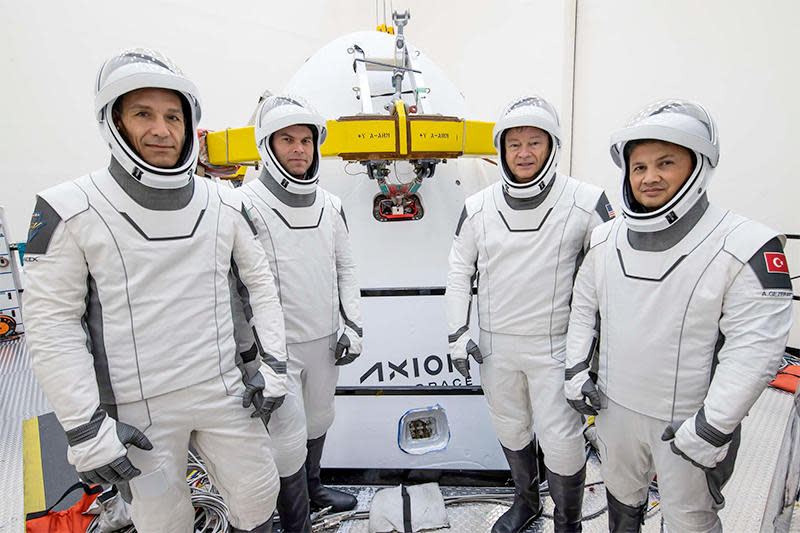After months of training and detailed planning, the most international crew yet to visit the International Space Station was cleared to blast off atop a SpaceX Falcon 9 rocket Thursday to kick off a two-week research mission, the third fully commercial flight to the orbital outpost.
With retired NASA astronaut Michael López-Alegría and Italian co-pilot Walter Villadei at the controls, flanked by Turkish mission specialists Alper Gezeravci and Marcus Wandt of Sweden, the Falcon 9 was set for takeoff from historic pad 39A at the Kennedy Space Center at 4:49 p.m. EST.
The launching originally was planned for Wednesday, but SpaceX ordered a 24-hour delay to complete a review of work to address a potential problem with the Crew Dragon capsule’s parachutes.
Launching directly into the plane of the space station’s orbit along a trajectory paralleling the East Coast of the United States, the Crew Dragon “Freedom” was expected to be released to fly on its own about 12 minutes after liftoff.
Along the way, the discarded Falcon 9 first stage, making its fifth flight, was programmed to fly itself back to landing at the Cape Canaveral Space Force Station.
If all goes well, López-Alegría and Villadei will monitor an automated approach to the space station, catching up from behind and below to set up a docking at the lab’s forward port at 5:15 a.m. Saturday.
They’ll be welcomed aboard by the station’s current seven-member crew: Soyuz MS-24/70S commander Oleg Kononenko and his two crewmates, Nikolai Chub and NASA astronaut Loral O’Hara, along with NASA Crew-7 commander Jasmin Moghbeli, European Space Agency astronaut Andreas Mogensen, Japanese flier Satoshi Furukawa and cosmonaut Konstantin Borisov.
One of America’s most experienced astronauts, López-Alegría, 65, holds dual U.S.-Spanish citizenship and is a veteran of five previous spaceflights and 10 spacewalks. Now chief astronaut at Houston-based Axiom Space, he commanded the company’s first commercial flight to the ISS — Ax-1 — in 2022.
Asked if he has any plans to hang up his spacesuit after the Ax-3 mission, López-Alegría smiled and said he’ll fly as long as he’s allowed.

“It’s a dream come true for me,” he told CBS News. “I will gladly continue to fly as long as the soul is willing, as long as the body is willing to do so. But seriously, this is really a privilege for somebody in my position to be able to go back to space, first of all, but especially to lead this very well-prepared and expertly trained group. It never gets old.”
During a planned 14-day stay aboard the station, the Ax-3 crew will carry out more than 30 microgravity experiments, most supplied by Italy, to learn more about the effects of weightlessness on a variety of physical and cognitive parameters.
In a lighter vein, the Italian company Barilla has provided ready-made pasta that will be heated up and taste tested “as part of an effort to develop a broader range of tasty foods in space for future space travelers,” according to Axiom.
Other research includes ways to use telemedicine to evaluate the health of astronauts in space, tests of a “smart flight suit” designed to “increase the psycho-physical comfort of the astronaut and to monitor medical data” and another project to test materials better able to shield astronauts from space radiation.
Once the experiments are complete, López-Alegría and his crewmates will strap back into their Crew Dragon and undock from the space station on Feb. 2 for a fiery plunge back to Earth and splashdown off the coast of Florida.
Police bodycams roll as man describes what happened before girlfriend stops breathing
Law enforcement response to Uvalde school shooting was a failure, Justice Department says
Senate to vote on spending bill that would push government shutdown deadline to March
Signup bonus from




